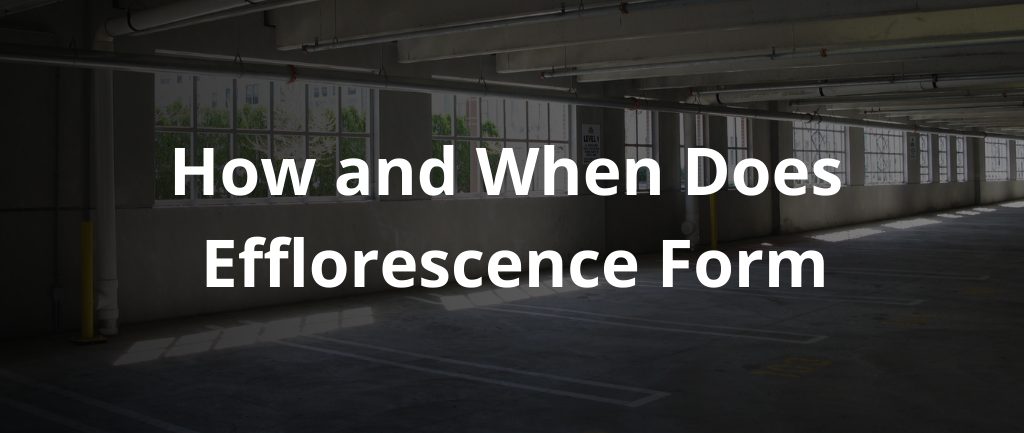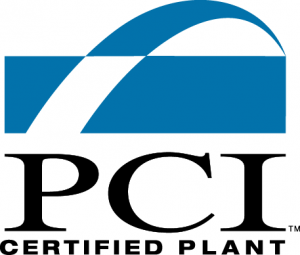
Jump To:
- What is Efflorescence?
- How Seasons Affect Efflorescence
- When Will Efflorescence Form?
- Removing Efflorescence
When reviewing the production and finishing of architectural precast concrete, the multi-step operation of panel finishing is subjected to influences such as weather conditions and the age of the concrete. Sometimes efflorescence appears, which complicates the process of approving the finished product for color and texture when comparing against the approved mock-up samples.
WHAT IS EFFLORESCENCE?
During the early stages of concrete curing, the hydrated cement contains some calcium hydroxide (lime) from the reaction between water and cement in the concrete mix. When the calcium hydroxide migrates through capillary action by water to the surface, as the concrete cures, it combines with carbon dioxide in the air to form a slightly soluble calcium carbonate. The result: a white-colored, crystalline deposit on the concrete surface known as efflorescence.
A second reaction where the calcium slowly reacts with additional water, allows the efflorescence to wear away when subjected to periodic precipitation. Another source of efflorescence is sulfates of sodium, potassium, calcium, and iron (ferrous); carbonates of sodium, potassium, and calcium; or sodium bicarbonate or silicate. While these water-soluble salts appear in chemical analysis as only a few tenths of one percent, they are enough to cause efflorescence when they leach out and concentrate on the surface.
HOW SEASONS AFFECT EFFLORESCENCE
Efflorescence, particularly affected by temperature, humidity, and wind when a slower rate of evaporation allows migration of salts to the surface, appears most often during winter production and finishing. Specifically, efflorescence is highly influenced by the concrete becoming wet and remaining damp for several days. At early concrete strengths under these conditions, the compounds have not had enough time to carbonate to any appreciable extent into the surface layer. After carbonation occurs, the quantity of calcium hydroxide, which reaches the surface of the product, is too small for visible efflorescence to be formed.
In the summer, even after long rainy periods, moisture evaporates so fast that a comparatively small amount of salt is brought to the surface. With the passage of time, efflorescence becomes lighter and less extensive, unless there is an external source of salts. The atmosphere also contains acid, such as sulfur dioxide. This can dissolve the calcium hydroxide deposits on the product’s surface. For this reason, efflorescence disappears faster in industrial regions compared with the purer air of a marine or mountain climate.
WHEN WILL EFFLORESCENCE FORM?
Efflorescence may appear immediately or within a few months of product casting, but since precast concrete decreases in porosity as it cures, efflorescence is much more of a short-term condition here than in concrete masonry construction. Increased cement contents and lower water/cement ratios, common to precast and prestressed architectural concrete, greatly decrease permeability, thereby reducing the magnitude and duration of efflorescence. Still, efflorescence is usually inevitable in the production of Portland cement concrete due to use of various admixtures, cement, and aggregates. For instance, cement with a higher alkaline content are more likely to produce efflorescence than cement of lower alkaline content.
REMOVING EFFLORESCENCE
Removing most types of efflorescence is relatively easy. Most efflorescing salts are water soluble, and many will disappear with normal weathering. In general, most efflorescence can be removed by dry brushing and then flushing with clean water. If this does not work, it may be necessary to wash the surface with a dilute solution of muriatic acid (5% to 10%); even a slightly acidic washing application may change the color and texture of the concrete, so it must be used with caution.
Dry cleaning such as sandblasting is preferred during winter weather to eliminate the application of water, which only serves to amplify the problem. Excessive sandblasting, however, may also change the color and texture of the finished product and must be avoided. Application of a clear water-repellent surface treatment is not recommended either since it creates a barrier for moisture attempting to escape the product and traps efflorescence at the surface beneath the sealer.
Nitterhouse Concrete Products, Inc. in Chambersburg, PA is available to answer any questions related to this topic, design, detailing, production, and erection of architectural and structural precast, prestressed concrete products. We are a family owned company serving the construction industry for over 90 years. Give us a call at 717-267-4505 or visit our website for information on quality precast, prestressed products to meet your design and construction needs.
Contact Nitterhouse Concrete Today



